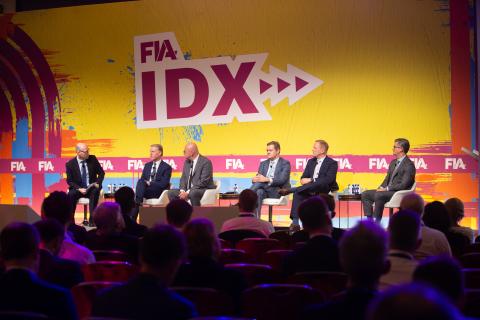European derivatives exchanges have delivered record trading volumes this year amid exceptional market volatility as trade war fears shook investors globally. In a discussion on the effects US President Donald Trump’s sweeping tariffs have had on their markets, the heads of two of Europe’s biggest exchanges said they are seeing a growing number of clients globally shifting their investment flows to the region.
Speaking at FIA’s International Derivatives Expo on 18 June, Robbert Booij, the chief executive officer of Eurex, said his exchange saw record volumes in April in fixed income and equity derivatives products after Trump’s ‘Liberation Day’ tariffs were announced.
“In terms of the composition of volumes, we see that there is an increased interest from clients outside of Europe to start trading more European products. There is also a shift and diversification taking place in asset management mandates. These usually take a few years, so that is not going to happen very quickly, but we do see a change happening there,” Booij said.
Stéphane Boujnah, the chief executive officer and chairman of the managing board at Euronext, agreed about a renewed interest in European markets, even suggesting there has been a “global reallocation of trust.”
Trading activity on Euronext intensified in April, with average daily volumes in equities reaching levels up to three times higher than those recorded in 2024. Trading in derivatives, foreign exchange and soft commodities followed a similar trend, he said.
“One of the unexpected facts around those events was that assets that are supposed to be uncorrelated all went in the same direction. Donald Trump succeeded in creating unprecedented correlation between assets that are not supposed to be correlated,” he noted.
“What is more important is what this means going forward. This is not a market correction. It is a fundamental shift, a reallocation of global trust. Global investors are reassessing their allocation strategies to minimise their exposure to the US market, which has become unpredictable in many respects.”
Boujnah added that the time is now ripe for Europe to advance its continental integration strategy. “This is the time to accelerate European capital markets integration, and to roll out the EU simplification agenda,” he said.
Exchange leaders on the panel agreed that the current environment will likely continue to drive derivatives volume, a fact that points both to uncertainty in the global environment and the vital role that derivatives play.
“Derivatives is all about risk management, and risk management is about coping with the unknown,” Boujnah added. “With the Washington-based unpredictable set of events, there is a stronger need to hedge, to manage risk and, hence, to use derivative products. We will see that trend around for a while.”
Daniel Maguire, group head of LSEG Markets and chief executive of LCH Group, labelled it the “Trump bump” when LSEG saw record volumes across products, including equities, fixed income, repo, FX and OTC rates. Looking ahead, he believes volumes will normalise, although not dip below previous levels.
“We are never more than a social media tweet away from more volatility. Things can change overnight,” he added.
Tariffs and metals
Tariffs have also created significant price volatility in the metals sector. Copper, often seen as a bellwether for the state of the global economy, saw prices drop sharply earlier this year in response to tariff speculation. Speaking on the panel, Matthew Chamberlain, the chief executive officer of the London Metal Exchange, said that despite the tariff blitz his markets performed normally.
“When the Trump administration announced a Section 232 investigation into copper and its derivative products, that created an expectation, but not a certainty, that there were going to be tariffs on copper,” Chamberlain said.
“What then happens is the spread between the LME global price and the regional prices become almost a way for people to express their view on the weighted average expected tariff, and that's great. That's what the markets are for. You then start to see all kinds of physical market effects, with metal flowing out of Asia and into the US to get there ahead of the tariffs,” he said.
“All of this is what our markets are here to do. The observation for us is managing that volatility. I'm really pleased that a lot of the lessons learned from the nickel situation in 2022 demonstrated their value in terms of managing volatility on exchange, reflecting real market conditions but ensuring underlying orderliness,” Chamberlain said.
And ESG, too
Almost immediately after taking office in January, Trump pulled the US out of the Paris climate agreement. That same month, the US exited the Network for Greening the Financial System, a global group of central banks and financial supervisors set up to address climate change.
Chris Rhodes, president of ICE Futures Europe, said that tackling climate change remains an important part of the UK and Europe’s policy agendas, despite the Trump administration’s deepening opposition to green measures, and ICE has a role to play in that.
In particular, he pointed to an announcement made during the recent EU-UK Reset talks about linking the EU Emissions Trading System, where heavy polluters buy permits to cover their carbon emissions, with the UK’s smaller version, calling it "a positive development". ICE plays a role in both schemes, hosting auctions for both EU and UK allowances.
“With the EU ETS 2, there is the inclusion of road transportation and buildings emissions, and that will affect 11,000 corporates in Europe. This is a key pillar in the EU’s strategy for net zero. Things are happening in Europe. ICE has the world's leading carbon market traded today that sits alongside our commodities and financial markets. Our job as a market infrastructure is to provide the right products to enable risk to transfer efficiently,” he said.


